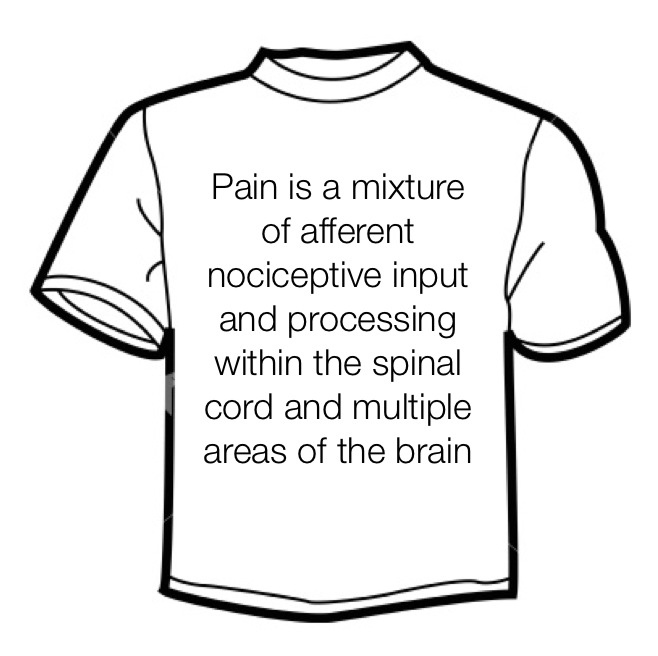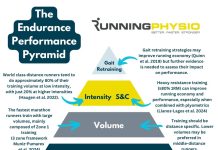Our articles are not designed to replace medical advice. If you have an injury we recommend seeing a qualified health professional. To book an appointment with Tom Goom (AKA ‘The Running Physio’) visit our clinic page. We offer both in-person assessments and online consultations.
Why talk about pain?
Understanding pain is a huge part of knowing how to manage it. Research has shown that education about pain is one of the most effective ways of treating it. In our NHS clinic, I run something called a Functional Restoration Programme for chronic pain, it’s mainly based on learning about pain and self-management and the results we get are excellent, sometimes even life-changing.
Not only will understanding pain help you manage it but it will often stop you from developing a chronic condition in the first place. This isn’t a piece specific to runners, like most of the content on the site, but rather an article for everyone!
So let’s start with a question…what is pain?
Running slogans would have you believe that “pain is weakness leaving the body” this is of course factually incorrect, but the truth doesn’t look so good on a T-shirt….
You’re probably wondering what on earth I mean by all that jargon. As complex as it sounds, it’s actually an oversimplification of what pain is and there is a lot we still don’t understand. So, in slightly more simple terms, the pain we experience is a mixture of sensations arriving from nerve endings in the tissues (skin, muscle, tendon, ligament etc) and the interpretation of these sensations by the brain.
In the diagram below is someone doing the splits. Nerve endings in the muscles react to the stretch by creating impulses that travel along the nerve (a little like electric current along a wire). These impulses then travel up the spinal cord (which is like a large bundle of wires together within a big cable) and reach the brain. The brain processes these signals in a number of areas which decides what we actually feel.
Broadly speaking, there are 3 different areas in the brain that process pain; emotional areas which process how we feel, cognitive areas which process how we think and sensory areas which interpret the quality of the sensation (sharp, dull, throbbing etc).
How we think, how we feel, our beliefs, experiences, environment and mood can all influence the severity of pain.
Embarrassing bodies did some simple pain experiments which show how variable pain experience can be;
Dr Christian’s ‘pain threshold’ was very changeable depending on what he was doing. You might think it would be fixed so that he would feel pain at a standard temperature each time but what research is finding is that the brain and nervous system has a huge effect on the pain we feel.
The brain can turn pain intensity up. A host of factors play a part;
Fear of damage – if you fear pain is due to lasting damage to your body then you are likely to experience more severe pain.
Fear-avoidance – often secondary to fearing damage. People can become fearful of movement due to pain and concerns about permanent damage, as a result, they avoid certain movements and activities. Avoidance of movement leads to muscle weakness and tightness, joint stiffness and increase nerve sensitivity, a process termed reconditioning.
Memory and past experience of pain – affect expectation and has a powerful impact on shaping our pain experience.
Hypervigilance – is very common with chronic pain and is often a feature of anxiety and depression. To be hypervigilant means to be constantly on the lookout for threats to our safety. In terms of pain, this means being constantly aware of any painful symptoms and always vigilant of how the body feels.
Pain focus – some people tend to focus their attention on their pain, this often goes hand in hand with hypervigilance and is likely to increase pain severity.
Catastrophisation – the tendency to lean towards a negative view of the situation and often associated with a tendency to ruminate (repeatedly think things over). According to Main et al (2010), “Pain catastrophising is a better predictor of pain-related disability and activity intolerance than pain itself“. What this means is that someone’s thinking in relation to their pain is a better indicator of their prognosis than the intensity of pain.
Feeling out of control – managing pain isn’t an easy process, when people try and fail they start to feel they have no control of their symptoms. Having pain that you can’t control is worrying and often interpreted by the brain as a greater threat resulting in more severe symptoms.
Stress and low mood – the body changes a great deal when under stress. We release more of certain hormones and chemicals within the body, these have been shown to slow healing and tend to result in experiencing more pain. Stress has multifactorial effects – it changes the body and influences how we think – it’s quite common for people’s pain to have a direct link to stress.
Anxiety and depression – mental health conditions are sadly quite common in the general population and are estimated to affect around 25% of people. If you look more specifically at people who attend physiotherapy it is thought that around 50-60% of people attending for treatment will also have a mental health condition. Anxiety and depression affect the way we think, feel and behave. They also have a variety of effects on the body. The overall result is that people with mental health conditions often experience more pain and a deterioration in their mental health can coincide with an increase in their pain. Several of the issues we’ve mentioned already are common with anxiety and depression; hypervigilance, fear, stress and low mood, loss of control, pain focus and catastrophising – so it’s easy to see how mental health can influence pain.
Fortunately, the brain can also turn pain intensity down by flooding the nervous system with very strong forms of pain relief that are reportedly many times more powerful than medications. It has a number of systems dedicated to this including something called ‘descending inhibition’ which works within the brain and spinal cord to stop some nerve impulses reaching the brain.
There are ways in which you can engage these systems that help to turn pain down.
Distraction – our attention can only hold so much information. As you read this your brain is receiving signals from every part of your body. The majority of these signals won’t reach your attention as they are filtered out. The same can be true of pain, especially if you are distracted. For a moment concentrate on your feet. What do they feel like? Warm? Cold? Can you feel your socks surrounding your feet? If you aren’t wearing socks can you feel the floor beneath you? When you draw your focus to your feet you realise how much information all the nerve endings are constantly sending to your brain. That information from your feet isn’t useful while reading this article and so is filtered out. Pain can be filtered out in a similar way. To see an excellent example of the power of distraction watch this video (from 1:28 to 6:11 looks at expectation, anxiety and pain, 8 minutes on to 13:33 examines distraction).
Pacing – this is such a vital topic that we have a specific article on pacing and pain. In a nutshell, it means doing as much as you can manage without increasing your pain. For example, if you can walk for 3 minutes but 4 starts to hurt, just walk for 3 minutes. This sounds like common sense but many people will keep going until the pain gets too much. In time you can then gradually increase your walking (or any other activity). Pacing puts you back in control of pain. By modifying activity a little you can reduce pain levels a lot!
Relaxation – most pain management programmes, including the excellent online ones from Paintoolkit, contain relaxation. This is because it has a vital role in helping our mental health. By relaxation I mean a formal relaxation technique, rather than just a glass of wine in front of the TV! Relaxation helps reduce anxiety and stress levels and in doing so can prevent catastrophising, hypervigilance and reduce that sensation of fear. Techniques like Progressive Muscle Relaxation also help decrease muscle tightness and improve sleep. For free relaxation podcasts that you can download to your phone see the excellent section in the Mental Health Foundation website.
Mindfulness – the concept of mindfulness is an ancient one but it’s only fairly recently become more of a part of mainstream pain management in the UK. It’s based around experiencing each and every moment in non-judgemental awareness and involves meditation to build this awareness. In each mediation, you focus on something (like your breath, sounds you can hear, your body etc) and you maintain that focus but notice your thoughts and feelings and how they pull your attention away from this focus. It’s a complex topic and one explained very well here. In the early ’80s the wonderful Jon Kabat Zinn conducted some research on patients with chronic pain. He treated people who had been through all that medical management could offer and yet still had pain. They completed a 10-week Mindfulness-Based Stress Reduction programme and over half reported at least a 33% reduction in pain and around a third showed at least a 50% reduction. Consider that for a moment…meditation was capable of reducing people’s chronic pain by up to 50%. Mindfulness has been shown to be helpful in managing anxiety and depression and some recent research suggests it may change activity in areas of the brain involved in regulating emotions. The awareness it cultivates often allows people to see how their thoughts and feelings are influencing them and to notice if they are catastrophising or fearful. ‘Noticing’ is the first step in changing. Once you become aware of these things you can then address them.
CBT – Cognitive Behavioural Therapy, like Mindfulness and relaxation has a role in improving mental health and through this helps to reduce pain. It helps people to identify and challenge negative thoughts and stop them from having an impact on mood and behaviour. One key though people often need to challenge is pain means damage. This association leads to fear of movement and can be at the root of people’s worries. Improving understanding helps to tackle this and it provides you with an alternative view. Living Life to the Full provides a free, online CBT programme (although it isn’t specific to pain).
Understanding – really understanding is what this piece is all about. The more you understand your body and pain the easier it is to cope with. Many people believe pain means damage, yet we’ve seen through what we’ve written above that the nervous system can become very sensitive and the brain can increase the severity of pain we experience, as a result you can have severe pain without damage. A patient challenged me on this once, she said, “if you put your hand in a fire it hurts and you’ll damage your hand. How can you say pain doesn’t mean damage?” It’s a very good question the answer lies in the context of the situation. You’d expect fire to cause damage. Most people with chronic pain get it in situations where there is no tissue damage – sitting, walking, turning in bed, putting on shoes etc. these are all normal situations we do every day, they don’t cause damage but if your back is sensitive they can cause pain.
The key messages to take from this piece are;
- Pain is complex and involves processing throughout the nervous system not just in the tissues.
- Pain doesn’t necessarily mean damage, normal everyday activities are unlikely to harm your body.
- Mood, stress and mental wellbeing can all affect pain levels.
- Pacing can help you regain control of pain.
- If you are aware of what turns your pain intensity up you can manage those things to help reduce pain.
- Likewise, if you know strategies to turn the pain down you can use these regularly to manage your symptoms.
This video touches on a lot of what we’ve covered;
Final thoughts: pain is a complex area and one in which research is constantly making new discoveries. If you are managing a chronic pain condition and haven’t tried a pain management approach ask your GP or health professional whether a programme might be suitable for you. They are available in most trusts on the NHS. If you don’t have chronic pain I hope you’ve found this interesting and that it might help you in managing pain in the future.
For more information on managing chronic pain see Paintoolkit’s excellent resource page and follow @paintoolkit2 on Twitter.












[…] Pain and the brain […]
Nice post, Tom.
It’s great to read more about the multi-dimensional approach to managing chronic pain, and it’s especially good to hear the example of an NHS chronic pain clinic that is getting good results. This is a clinical and research interest of mine in Australia, and a management paradigm that is still unfortunately not very well known.
Thanks, and keep up the good work.
Luke.
[…] I haven’t quoted any studies but most of the theories with regard to current concepts on pain are best summarised in Tom’s blog here. […]
great article Tom. The first 2 videos are listed as private. Can you give another link to those?
Comments are closed.